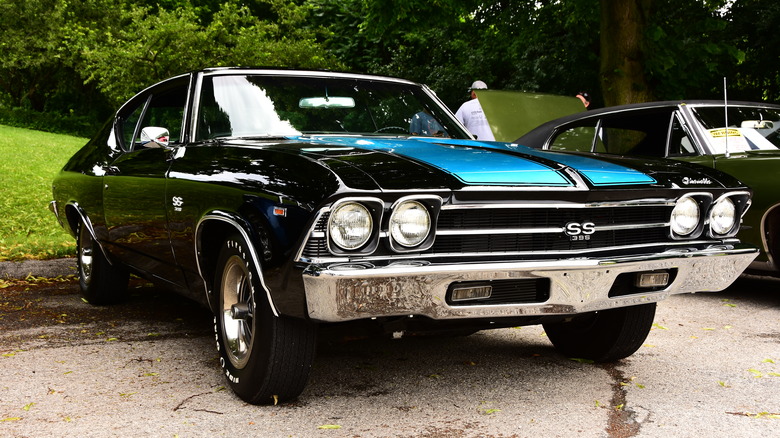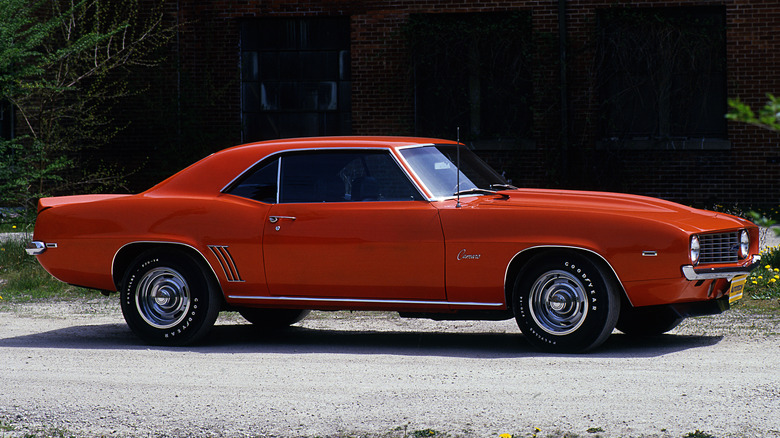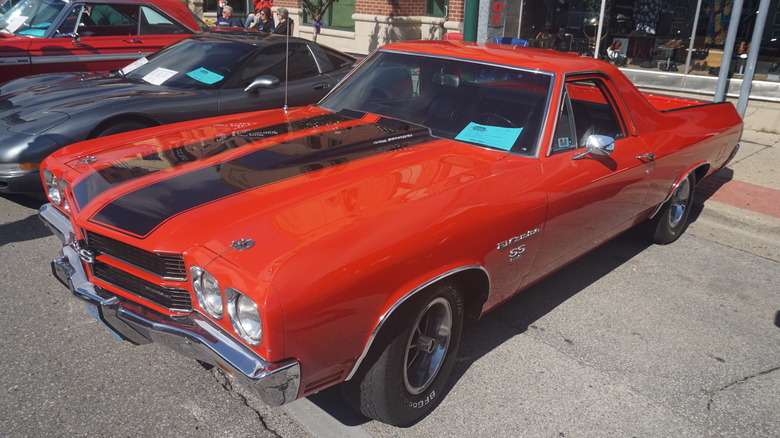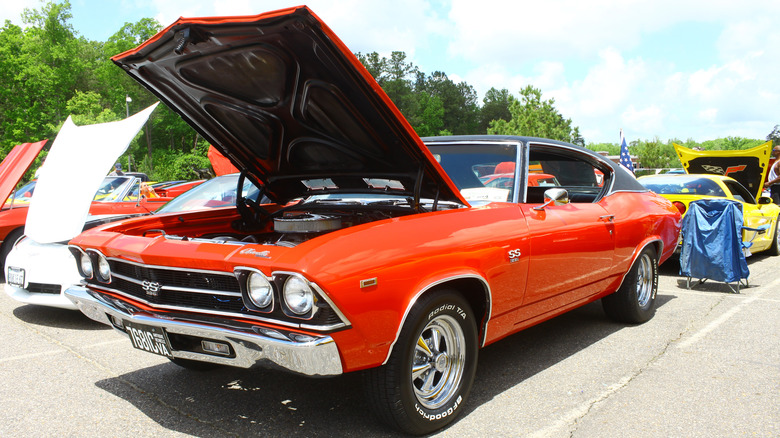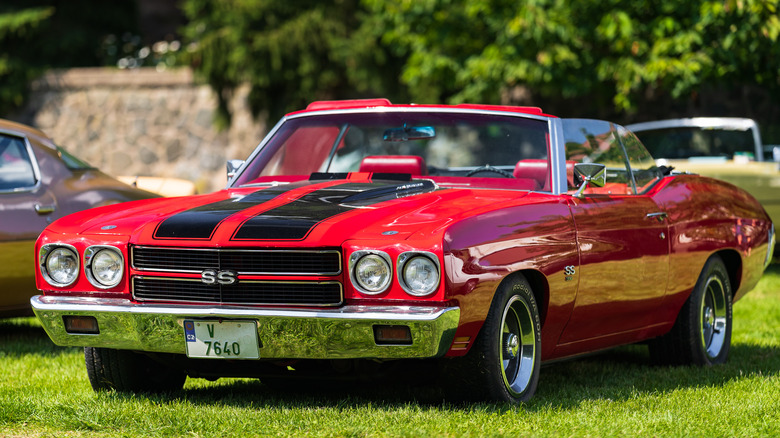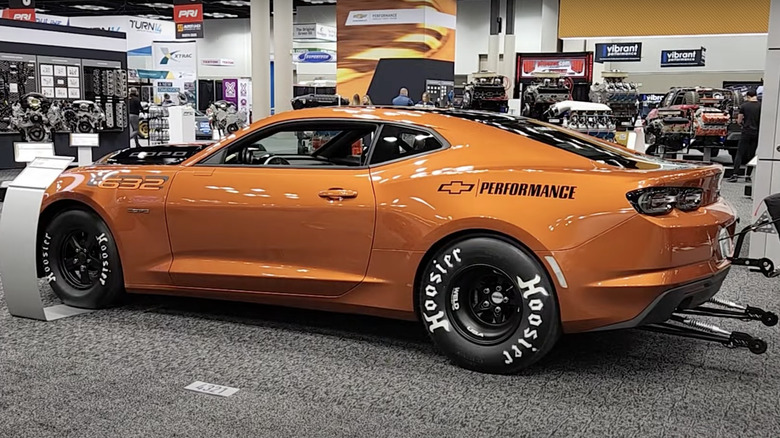The 5 Most Impressive Chevy Muscle Cars Of All Time
Before Louis Chevrolet lent his name to one of the United States' most legendary car brands, he was a dominant driver for Buick's racing team. GM founder William Durant lost control of the company after a failed 1909 attempt to acquire Ford, but he teamed up with Chevrolet to form a new venture. The Chevrolet Motor Company was so successful that Durant was able to retake control of GM in 1916, and Chevy has remained a cornerstone of the U.S. auto industry ever since.
Chevy has produced the Corvette through eight bone-rattling generations since its debut in 1953 and was a force in the muscle car era of the 1960s and early '70s. Highlights from that time include the Camaro, which first appeared in 1967 and lived through six generations of its own before getting dropped, at least for now, in 2023. The Camaro could be resurrected as a muscle EV à la the Ford Mustang Mach-E or 2024 Dodge Daytona R/T and Scat Pack.
Regardless of what Chevy does with the soon-to-be-shelved Camaro badge, it has a deep catalog of grin-inducing, gas-guzzling beasts that look as good as they perform. Here are five of the most impressive Chevy muscle cars of all time.
1969 COPO Camaro ZL1
1969 marked the end of the Camaro's first generation. At the end of a three-year production run of nearly 700,000 units, Chevy issued a COPO (Central Office Production Order) version Camaro ZL1. Only 69 of the more than 243,000 '69 Camaros got the COPO 9560 option package. It was the creation of Fred Gibb, an Illinois Chevy dealer who ran drag races on the side. The year before, he had built 50 COPO Novas with 396 cubic-inch engines, and Gibb went even bigger for the '69 COPO Camaro.
The car got a lightened version of the NASCAR-bred 427 cubic-inch V8, which used an aluminum block, heads, and intake manifold. The only steel used in the ZL1's engine was for the hardened shafts and rods. Although output was listed at 430 horsepower, race-tuned ZL1 engines could make as much as 550. A less expensive 9561 package was also offered, with an iron L72 427 V8 that weighed 76 pounds more than the ZL1.
The 1969 COPO Camaro Zl1 was incredibly fast, with a blistering 0-60 time of 5.3 seconds. In addition to the 69 COPO 9560 Camaros Gibb ordered, about a thousand 9561 COPO Camaros were also made. If you can find one of the rare surviving examples, expect to pay more than $100,000 to drive it home. That's a decent appreciation from the original sticker price of $7,324.25, which equals a little more than $64,000 today.
1970 El Camino SS
Chevy introduced the El Camino in October of 1958 as a 1959 model. It was a counterstrike to Ford, which had been producing the Ranchero for two years. The El Camino didn't sell as well as Ford's ute, though, and Chevy nixed the first-gen El Camino after two years. A more powerful version appeared in 1964, based on the Chevelle platform. For 1968, the El Camino was given the SS treatment along with the Chevelle. That meant a 396 cubic-inch V8, which remained the largest available powerplant until 1970.
That year, Chevy added its 454 cubic-inch LS6 big block to the list of options for the El Camino. That turned Chevy's ute into a true reverse mullet party-in-the-front, business-in-the-back vehicle, with a maximum output of 450 horsepower and the ability to haul a few hundred pounds of gear in back. The 454 stayed in place as an option alongside the 396 through 1972 and could hurl the El Camino from 0-60 in the low five-second range — an astonishing feat for a vehicle with the ability to haul messy cargo.
[Featured image by Michael Barera via Wikimedia Commons|Cropped and scaled|CC-By 4.0]
1969 Chevelle SS 396 L78
The COPO Camaro wasn't the only high-performance option package offered by Chevy dealers in 1969. The SS 396 had been issued as a separate model the year before but was brought back under the Chevelle badge for 1969. The SS 396 Chevelle cost an extra $348 (a little over $3,000 today) and added a 396 cubic-inch V8, plenty of chrome badges announcing its presence, and five-spoke mag wheels. For another $252.80 (about $2,200 today), buyers could select the L78 option that boosted horsepower from 325 to 375 and added a heavy-duty multi-link suspension.
The L78's engine had a forged steel crankshaft and connecting rods, domed aluminum pistons, and a Holley four-barrel carburetor sitting atop the aluminum intake manifold. L78 Chevelle buyers could choose from a three-speed or two four-speed manual gearboxes or the TH400 three-speed auto. The L78 could go from 0-60 in six and a half seconds and cover a quarter mile in 14.5 ticks of the stopwatch. The L78 Chevelle was special but not particularly rare. Chevy sold a little more than 86,000 Chevelle SS396s that year, and 9,000 of them came with the L78 package. The less common choice was the L89 package, which topped the L78 engine with aluminum heads and was chosen by only about 400 customers.
1970 Chevelle SS 454 LS6
As mighty as the '69 Chevelle SS 396 was, Chevy outdid itself with the following year's high-performance version of the model, the SS 454. The LS6 version of its massive 454 cubic-inch V8 made an absolutely bonkers 450 horsepower — more than any factory-issued engine at the time. The Holley four-barrel carburetor fed 800 cubic feet per minute of air to the engine through an aluminum intake manifold, and inside the engine were solid lifters, a forged steel crank and rods, and forged aluminum pistons.
This combination of strength and light weight made the Chevelle SS 454 a formidable beast with a 0-60 time of under 5.5 seconds. The LS6 might have been too much engine for American roadways, though, especially with the looming oil crisis and shifting attitude toward muscle cars. The '70 Chevelle only averaged a little better than nine miles per gallon, but efficiency was never going to be the reason this model entered the muscle car pantheon.
2023 COPO Camaro ZZ 632
After its debut in 1969, Chevrolet shelved the COPO Camaro until 2011, when it unveiled a concept version at the Specialty Equipment Market Association (SEMA) show in Las Vegas. It produced just 69 copies of the beast in each of the next four years, despite high demand. The 69-unit production runs and 427 cubic-inch (7.0 liter) V8 were a tribute to the original COPO Camaro, and supercharged 5.3 and 6.5 liter engines were also available. Unlike the original, the modern COPO Camaros aren't street legal and are made to run in NHRA Super Stock and Stock Eliminator races. This means niceties like power steering and sound insulation were yanked in favor of safety considerations like a roll cage and racing seats with harnesses.
Chevy brought the COPO Camaro back for 2023 but without limiting production to just 69 units yet again. Engine options for the latest edition include the traditional 427 cubic-inch V8, a supercharged 5.7 liter (350 cubic inch) motor, and the downright scary 632 cubic inch (10.35 liter) ZZ632 V8 that makes 1,004 horsepower and 876 pound-feet of torque. The ZZ632 was initially crafted by Chevrolet Performance as a crate racing engine and topped our list of Chevy's highest-horsepower engines ever built. A 2023 COPO Camaro cost even more than a 1969 version, with prices ranging from roughly $126,000 to $141,000 depending on the engine choice.
